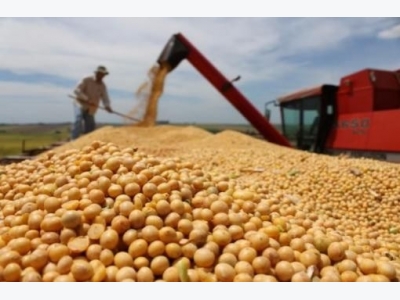Vietnams soybean imports to rebound in 2017 - USDA

Importers could benefit from recent falls in U.S. soybean futures, which dropped to the lowest level in a year on April 13.
Vietnam is forecast to import 1.7 million tons of soybeans this year, a rebound of 6 percent after a fall in last year's overseas purchases following higher demand for animal feed production and from the food processing sector, the U.S. Department of Agriculture has said.
The Southeast Asian country has been relying on imports of soybeans and soymeal for years to feed its rapidly expanding fish and shrimp export sectors, which have gained a significant foothold in the European Union, the U.S., Japan, Australia and South Korea.
Vietnam produced just 147,500 tons of soybeans in 2016, up 0.8 percent from the previous year thanks to higher yields, even though the total acreage shrunk nearly 7 percent in the same period to 94,000 hectares, government statistics showed.
It imported 1.55 million tons of soybeans in 2016, down 9 percent from the previous year, Vietnam Customs data showed.
The fall came due to a decline in crushing production in the northern region, a USDA attache said in a report published last week.
It forecast the country's soybean imports will rise to 1.7 million tons this year, and further advance to 1.75 million tons in 2018 on additional crushing capacity with a new plant in the northern province of Bac Ninh that will open in March 2018, along with expanded capacity in the southern region.
"The livestock and aquaculture industries continue to drive the demand for feed and soybeans, and will motivate further development of the domestic crushing industry," the USDA report said.
Last year, more than half of Vietnam's soybean imports came from the U.S., followed by Brazil, Canada, Argentina and Paraguay, the report said.
Vietnam's animal feed output is projected to rise to 24 million tons this year from 20.2 million tons in 2016, the report cited forecasts by the agriculture ministry and domestic feed producers.
Imported soybeans are crushed to make crude soy oil and soymeal.
The country's consumption of soybean products, namely soya milk, tofu and other soybean-based drinks, is forecast to rise between 7 percent and 7.5 percent in 2017, the report said.
Soybean importers may benefit from recent falls in U.S. soybean futures, which dropped to their lowest levels in a year on April 13 after the U.S. Department of Agriculture raised its projections of the Brazilian and Argentine soy harvests, Reuters reported. The decline also followed a March 31 USDA report projecting a jump in U.S. soybean plantings to record levels this year.
Vietnam spent nearly $900 million to import animal feed in the first quarter of this year, up 33 percent from the same period in 2016, compared with a year-on fall of 22 percent in January-March last year, based on Vietnam Customs data.
In a related development, the country's corn demand is also expected to rise in 2017, after imports last year rose 11 percent from 2015 to 8.44 million tons, while the value edged up 1.2 percent to $1.67 billion, customs data showed.
Imports have been rising due to limited domestic output. Corn output last year eased 1 percent from 2015 to 5.22 million tons due to less planting area and lower yields, according to government statistics.
Related news
 New coffee project to benefit 15,000 farmers
New coffee project to benefit 15,000 farmers A project to develop the Buon Ma Thuot coffee brand is expected to benefit more than 15,000 farmers who live in a poor commune in the Central Highlands province
 Vietnam cooperative to export mangoes to Australia
Vietnam cooperative to export mangoes to Australia The Suoi Lon Mango Cooperative in the southern province of Dong Nai will export its first batch of mangoes to Australia soon
 Campaign “rescues” ripe bananas
Campaign “rescues” ripe bananas The supply-demand link was the top priority over the past seven years of the Buy Vietnamese Goods campaign.